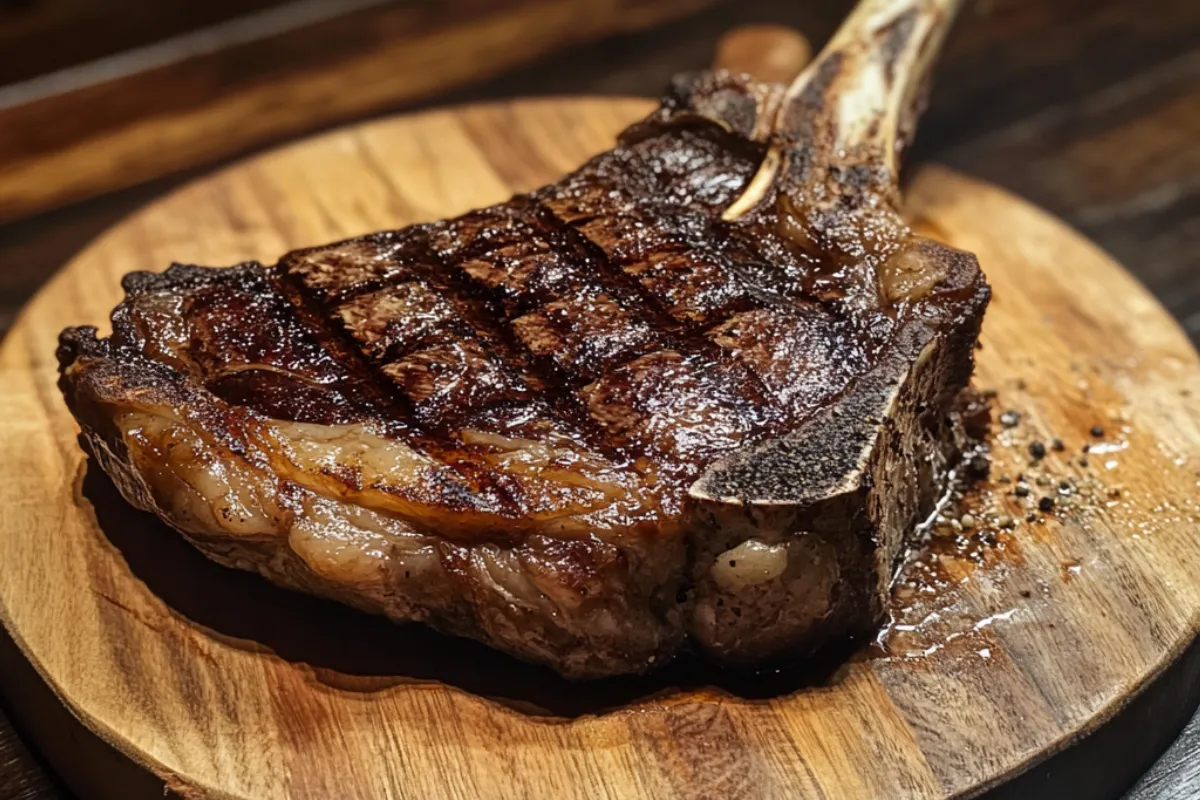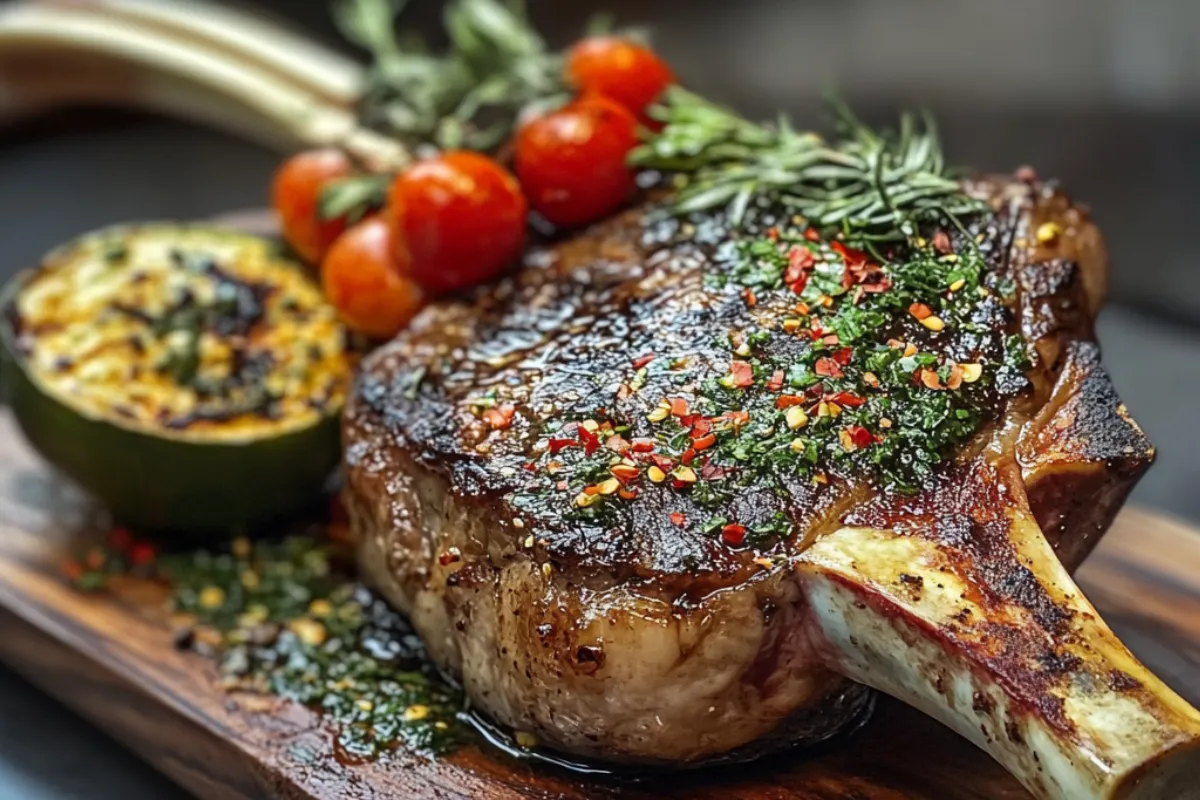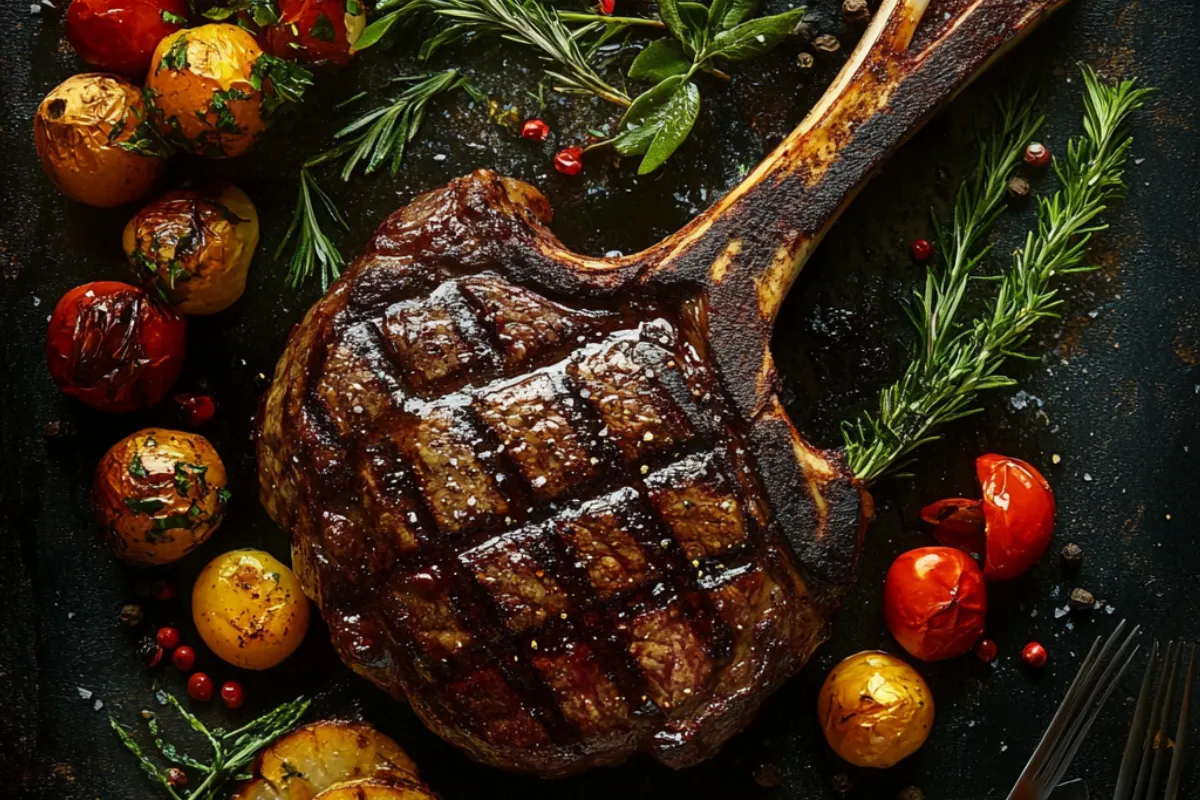When it comes to the world of steaks, two of the most popular options are Tomahawk and Ribeye. These cuts are well-known for their rich flavor and tender texture, but each has its own unique qualities. If you’re wondering which steak is the better option for your next meal, this article will help you understand the differences between the two cuts, including factors like taste, cooking methods, and price. So, let’s dive into the Tomahawk steak vs. Ribeye debate!

What Is a Tomahawk Steak?
A Tomahawk steak is essentially a ribeye steak but with a large portion of the rib bone left attached. This long bone, which resembles a tomahawk axe, is what gives the steak its name. But the Tomahawk steak isn’t just about looks – the bone actually helps insulate the meat during cooking, which can result in more even heat distribution and a tender texture. If you’re looking to impress guests or make a statement at your next cookout, the Tomahawk steak is definitely a showstopper.
For a deeper look into how to properly cook and enjoy this magnificent cut, check out this ultimate guide to Tomahawk steak.
Key Features of Tomahawk Steak
- Presentation: The bone gives the steak a striking, rustic appearance.
- Flavor: The bone adds an extra depth of flavor that some believe enhances the taste.
- Size: These steaks are often larger and thicker, typically ranging between 30 to 45 ounces.
- Cooking: The larger size and bone mean the steak takes longer to cook, especially when compared to a boneless ribeye.
You can read more about what makes the Tomahawk steak so special in this comprehensive guide.
What Is a Ribeye Steak?
The Ribeye steak is cut from the rib section of the cow, just like the Tomahawk, but without the long bone. It is known for its rich marbling of fat throughout the meat, which gives it a tender, juicy flavor when cooked. Whether you’re grilling, pan-searing, or broiling, the Ribeye is versatile and perfect for almost any occasion.
Learn more about how the bone impacts meat flavor, and how it enhances your dining experience.
Key Features of Ribeye Steak
- Marbling: The fat throughout the steak ensures a juicy, flavorful bite.
- Size: Ribeyes tend to be smaller than Tomahawk steaks, making them easier and faster to cook.
- Cooking Methods: Ribeye can be cooked in various ways, including grilling, broiling, or pan-searing. Its marbling allows it to remain tender regardless of the method.
- Boneless Option: Many people prefer boneless Ribeye steaks because they cook more evenly and quickly than bone-in versions.
Tomahawk Steak vs Ribeye Steak: The Main Differences
So, what sets these two cuts apart? Let’s take a closer look at the main differences between Tomahawk steak and Ribeye steak.
1. Bone Structure
The most obvious difference between the two cuts is the bone. The Tomahawk steak retains the full rib bone, while the Ribeye can come boneless or with a smaller portion of the bone. The presence of the bone in the Tomahawk is mostly for presentation, but some argue it also contributes to the overall flavor.
2. Size and Thickness
Tomahawk steaks are generally much larger than Ribeye steaks, thanks to the bone and the thick cut of meat. If you’re looking for a steak that can serve multiple people, the Tomahawk may be the better option. A Ribeye steak, on the other hand, is typically a smaller, more manageable portion for one person.
3. Cooking Time
Due to the size and bone, Tomahawk steaks take longer to cook than Ribeye steaks. If you’re looking for a quicker meal, Ribeye may be the better option.
4. Price
Another key difference is the price. The presentation and size of the Tomahawk often make it more expensive than a Ribeye. You can read more about why the Tomahawk steak commands a higher price in this article on steak pricing.

Cooking Techniques for Tomahawk Steak
Cooking a Tomahawk steak can be a bit more challenging due to its size and bone structure. However, with the right technique, you can achieve a perfect, tender steak that will impress any dinner guest. Here are a few methods to consider:
- Grilling: Grilling a Tomahawk steak is perhaps the most popular method. The bone helps protect the meat from drying out, and the high heat of the grill will create a delicious sear.
- Reverse Sear: This technique involves slow-cooking the steak at a low temperature and then searing it at the end for a crispy exterior and juicy interior.
- Oven Roasting: For a more hands-off approach, you can roast the steak in the oven after searing it in a pan.
For more detailed instructions on how to cook a Tomahawk steak, check out this cooking guide.
Cooking Techniques for Ribeye Steak
The Ribeye steak is known for its rich flavor and tender texture, making it a favorite among steak lovers. Its versatility allows for various cooking methods, depending on your preferred style and level of doneness. Here are some popular techniques to cook a perfect Ribeye steak:
1. Grilling
Grilling is one of the most common and effective ways to cook a Ribeye. The high heat of the grill sears the outside of the steak, creating a delicious crust, while keeping the inside juicy and tender.
How to Grill Ribeye Steak:
- Preheat the grill to high heat (about 450°F to 500°F).
- Season the steak generously with salt, pepper, and your preferred herbs.
- Place the Ribeye on the grill and sear each side for 3-4 minutes, ensuring a crispy, charred crust.
- Move the steak to indirect heat (or reduce the heat if using a gas grill) and cook to your desired doneness (about 5-7 minutes for medium-rare).
- Let the steak rest for 5 minutes before serving to retain juices.
2. Pan-Searing
If you don’t have access to a grill, pan-searing a Ribeye steak is a quick and easy alternative. A hot skillet creates a great sear on the steak, locking in all the flavorful juices.
How to Pan-Sear Ribeye Steak:
- Heat a cast-iron skillet over high heat until it’s smoking hot.
- Add a tablespoon of oil (vegetable or canola oil works well) to the skillet.
- Season the steak generously with salt and pepper.
- Place the steak in the skillet and sear for 2-3 minutes per side, flipping once.
- To finish, add butter, garlic, and fresh herbs like thyme to the skillet, and baste the steak for an additional 1-2 minutes for extra flavor.
- For thicker steaks, finish cooking in a preheated oven at 400°F until your preferred doneness is achieved.
- Allow the steak to rest for a few minutes before slicing.
3. Broiling
is another excellent way to cook a Ribeye, especially if you want to achieve a nice crust without the need for a grill. Broiling uses high, direct heat from above to cook the steak quickly.
How to Broil Ribeye Steak:
- Preheat your oven’s broiler to high and position the rack 4-6 inches from the heat source.
- Season the steak with salt, pepper, and any other seasonings you like.
- Place the steak on a broiler pan or a baking sheet with a wire rack to allow airflow.
- Broil the steak for 5-6 minutes on each side for medium-rare, adjusting the time based on your preferred doneness.
- Let the steak rest for 5 minutes before serving to retain the juices.
4. Reverse Sear
The reverse sear technique is ideal for thicker Ribeye steaks. This method involves cooking the steak at a low temperature first and finishing it with a high-heat sear, resulting in a perfectly cooked interior and a crispy, flavorful exterior.
How to Reverse Sear Ribeye Steak:
- Preheat your oven to 250°F.
- Season the Ribeye with salt and pepper.
- Place the steak on a wire rack over a baking sheet and cook in the oven for 20-30 minutes, or until the internal temperature reaches 120°F for medium-rare.
- Heat a cast-iron skillet over high heat and sear the steak for 1-2 minutes on each side until a deep brown crust forms.
- Rest the steak for a few minutes before serving.
5. Sous Vide
The sous vide method is a precise way to cook a Ribeye steak to your exact preferred doneness. This technique involves vacuum-sealing the steak in a bag and cooking it in a water bath at a controlled temperature. The result is a steak that is evenly cooked all the way through.
How to Sous Vide Ribeye Steak:
- Preheat the sous vide water bath to 130°F for medium-rare.
- Season the steak with salt, pepper, and any desired herbs. Place it in a vacuum-seal bag or a resealable plastic bag using the water displacement method.
- Cook the steak in the water bath for 1 to 3 hours.
- Once finished, remove the steak from the bag and pat it dry.
- Heat a cast-iron skillet over high heat and sear the steak for 1 minute on each side to create a crust.
- Let the steak rest for a few minutes before serving.
Tips for Cooking the Perfect Ribeye
- Room Temperature: Always let your Ribeye steak come to room temperature before cooking to ensure even cooking.
- Resting Time: After cooking, allow your steak to rest for about 5 minutes. This allows the juices to redistribute within the meat, ensuring every bite is tender and juicy.
- Seasoning: A Ribeye steak has enough natural flavor, so a simple seasoning of salt and pepper is often sufficient. However, you can also experiment with garlic, rosemary, thyme, and butter for extra richness.

Which Is Healthier: Tomahawk or Ribeye?
While both Tomahawk and Ribeye steaks come from the same section of the cow, their nutritional profiles can vary slightly due to their size and fat content.
Nutritional Breakdown
- Tomahawk Steak: A Tomahawk steak is typically larger and contains more fat, especially around the bone. This can make it higher in calories compared to a standard Ribeye.
- Ribeye Steak: Ribeye steaks tend to be leaner, especially if you choose the boneless version. They are still rich in flavor due to their marbling, but they may be slightly healthier depending on how they are cooked.
If you’re concerned about calories or fat content, a boneless Ribeye might be the better choice for you.
Cost and Value: Is Tomahawk Worth the Price?
One of the key factors to consider when deciding between a Tomahawk and a Ribeye steak is the cost. As mentioned earlier, Tomahawk steaks are generally more expensive due to their size and presentation. But is the extra cost worth it?
Factors Affecting the Price
- Bone-In Presentation: The long rib bone in the Tomahawk adds to the overall cost, but it doesn’t necessarily contribute much to the flavor.
- Size: Because Tomahawk steaks are larger, they tend to be more expensive simply due to the amount of meat.
- Value: If you’re looking for a visually impressive steak to serve at a special occasion, the Tomahawk steak might be worth the splurge. However, for everyday meals, a Ribeye steak can offer the same delicious flavor at a more affordable price.
Conclusion: Which Steak Is Better for You?
So, is Tomahawk steak better than Ribeye? The answer depends on what you’re looking for in a steak. If you want a large, visually stunning steak to impress your guests, the Tomahawk steak is the way to go. However, if you’re looking for a more affordable, easy-to-cook option, the Ribeye steak is the better choice.
Ultimately, both steaks are incredibly flavorful and tender, making either option a great choice for your next meal. Whether you choose the Tomahawk or Ribeye, you’re sure to enjoy a delicious steak that’s packed with flavor and cooked to perfection.
For more information about what makes the Tomahawk steak so expensive, you can read the full article here.

